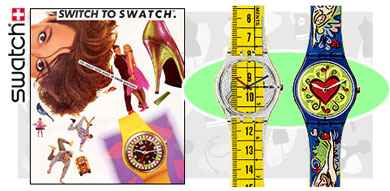Swatch watch

Fashion Synopsis
Always new, always different. With Swatch, your watch was never plain, boring or dull.
How many Swatch watches can fit on the average person’s wrist? Three was common, two was a must, and four was plain insane! And don’t think that just one will pass the test. At no other time in history was the wearing of multiple watches a reflection of social standing (as opposed to a symptom of mental illness) like the über-cool, Swatch-crazed 80’s.
Swatch watches were the product of a desperate attempt of Swiss watchmakers to regain their fame and fortune as the birthplace and home of premiere watch construction. Asian digital watch technology was destroying the Swiss market for, and when Japan released the affordable “Delirium” watch in 1979, the Swiss were reeling. SMH, the Swiss Corporation of Microelectronics and Watchmaking Industries, was a collective of watch manufacturers facing a severe threat to their national product.
Nicholas G. Hayek, head of Hayek Engineering, did an analysis of the market and discovered a new trend in watches: no longer were people investing exorbitant amounts in luxury watches. They wanted the inexpensive, but technologically advanced watches that were being produced by makers like Casio and Seiko. The Swiss cornered 97% of luxury timepieces, and were desperate to keep their place. The SMH collective needed a new product in the low price range to compete with the Asian products, and the answer was Swatch.
Swatch was a revolutionary idea in timepiece construction, and its debut in 1983 changed the fate of watches forever. Swatch was inexpensive (approximately $35), yet fashionable. No longer did your wrist have to support one watch for many different moods, as Swatch designed watches for leisure, formal, business, and just plain fanciful. Swatches were so affordable, and so unique in design that collecting became widely practiced, with a stockpiling of Swatches insuring the continued success. Swatch was more than a watch—it was an image.
Swatches were slim, with easily bendable bands in exciting colors and designs. They consisted of 51 components, instead of the 100-150 most watches utilized. This technological construction not only insured faster production and less cost, but ultimately meant fewer items to break. But no matter, because the Swatch was designed to be disposable, or at least non-repairable. Sold in clear plastic cases, the Swatch had an air of trendiness…when you get tired, just buy a new one. But no one wanted to get rid of an old Swatch, and the trend of multiple watches on one wrist became one of the biggest fads of the 80’s.
Swatch looked to children’s Legos toys for their bright, injection mold plastics and modeled the watch after the sleekness of disposable lighters. Their product was unlike anything the watch world had seen before. Swatch didn’t just hire watchmakers, but added graphic artists, architects, and industrial designers to the team. Each Swatch watch was a work of art, a personal statement to, and about, the wearer.
Each Swatch had a name, like “Black Magic” or “Chrono Tech,” with accompanying graphics and artistry. The demand for Swatches was so great that the company released new editions throughout the year, and hundreds of different styles have been created. Celebrity artists released limited edition versions, with Kiki Picasso, Yoko Ono, Keith Haring and Pedro Almodovar all lending their visions to the face of a Swatch. To protect these valuable pieces of wrist-art, the company sold Swatch guards, plastic protectors worn over the watch dial.
Swatch fanatics continue to collect each new edition as it is released, with some Swatches going for thousands of dollars on the auction market. The Swiss watch market, now run by Swatch Group, not only successfully competed against Asian technology, but insured an ongoing obsession with Swatch watches long after their 80’s fad days.
Fashion Sub Categories
girl's apparelboy's apparel
accessories
brands
